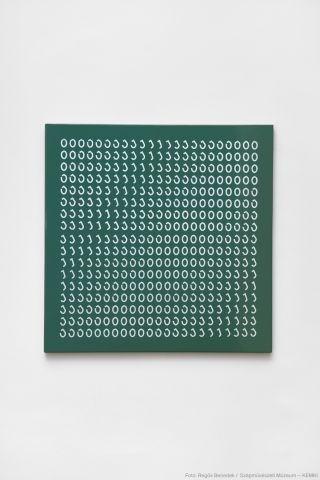‘exhibition history’
- « previous
- 1
- 2
- 3
- 4
- next »
GRÓF Ferenc: Somewhere between 0 and 1 (Hungarian National Painting Grey), 2016–2023
… The work is directly connected to the face of the sundial presented at the Kiscell Museum’s exhibition entitled Without Index (2016),[1] alluding to the state of uncertainty that characterises the city described in Tibor Déry’ s novel Mr. A.G. in X (1964), which served as a reference point of the exhibition. In this fictional city, all exists in a state of constant oscillation between the nothingness of Zero and the certainty of One, creating a grey area that forever changes its …
The Estate of Lajos Tihanyi
… delivered to Hungary in 1970. In 1973, the Hungarian National Gallery organised a large-scale exhibition of Lajos Tihanyi’s life and oeuvre, which also included these objects from Paris. The ADK collection of the Museum of Fine Arts – Central European Research Institute for Art History (formerly the Art Archive of the Hungarian National Gallery) contains, among other things, Tihanyi’s correspondence with his artist and writer friends—a valuable and significant resource—as well as the …
Gyula Derkovits Fonds
… a lesser known side of the artist. Among the printed material, one finds catalogues, invitations, exhibition posters, lists of works and exhibition plans documenting Derkovits’s career path. With regards to the history of how Gyula Derkovits’s art was received through the decades, the essays and studies (by Lajos Kassák, Zoltán Farkas, Éva Körner, Lajos Vayer, Zoltán Székely) published during his lifetime and after his death, as well as the press releases found in the material, are of notable …
Fond of Ilka Gedő
… the creation of oil paintings in diary form. The remaining notebooks mainly contain notes on art history and color theory, translations, and diaries. The notebooks are supplemented by 191 letters. The detailed contents of the manuscript legacy are listed in Hungarian and English in Appendices 2 and 3. The fond of Ilka Gedő is preserved by the Museum of Fine Arts – Central European Art History Research Institute (KEMKI) Archive and Documentation Center (ADK) under the inventory …
Mission and Goals
The Central European Research Institute for Art History (KEMKI) was established in 2021 as an affiliate of the Museum of Fine Arts, Budapest. Our mission is to strengthen Hungary's academic discourse and represent Hungarian art and art history at a high standard globally by initiating and implementing locally focused, regional and international research projects and collaborations connected to art-historical issues. The research conducted …
- « previous
- 1
- 2
- 3
- 4
- next »



